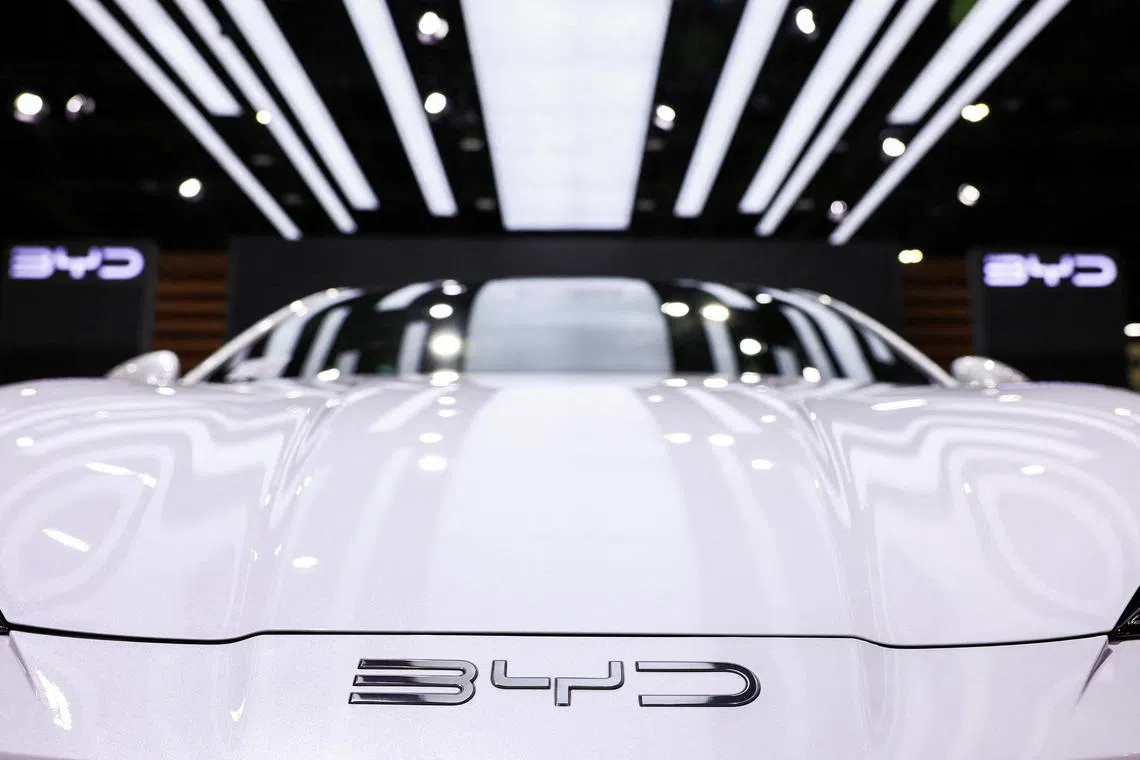A to Z of 2024: Electrified vehicles go further than ever
Sign up now: Get ST's newsletters delivered to your inbox

Chinese carmakers like BYD are starting to export hybrid models capable of an incredibly long range before needing a refuel.
PHOTO: REUTERS
Follow topic:
SINGAPORE – It is just as well that the candies and soft drinks sold at petrol stations cost as much as they do, because people will not be patronising such convenience stores as often as they did before – not with the rising popularity of electric vehicles (EVs) and advancing technology that keep motorists away from the pumps.
Hybrid vehicles, which combine the petrol engine with electrification, promise long operating range and lower fuel bills. They also allow those not sold on full EVs and their reliance on the charging network to get a taste of electric motoring.
If variety is the spice of life, shopping for electrified vehicles in 2025 will be more thrilling than a mala hotpot dinner.
The excitement over full EVs may seem to be cooling abroad, but Singapore is still obsessed with them.
In the first 10 months of 2024, EVs made up 32.7 per cent of new car registrations, up from 18.1 per cent over the whole of 2023.
The final 2024 vehicle registration count may not be out yet, but it will be a surprise if Chinese EV brand BYD does not end up being Singapore’s best-selling brand.
As at end-October, BYD had 4,560 registrations, outselling every other mass-market brand that deals in petrol-hybrid and combustion-engine models.
There were 31 brands in Singapore offering full EVs in 2024, up from 22 brands in 2023.
The options available stretch from the Rolls-Royce Spectre two-door coupe that costs more than $2 million to the compact Dongfeng Box costing less than a tenth of that amount. In terms of body styles, there are two- to seven-seaters, at least one of which is a retractable soft-top model, plus a station wagon and many different sport utility vehicles (SUVs).
Plug-in hybrid models capable of almost intercontinental range between fill-ups are on the way. As the name suggests, these vehicles can fill up their batteries with EV chargers instead of depending only on the engine when the car is running, as with conventional petrol-hybrids.
Plug-in hybrids can appeal to buyers who are apprehensive about relying on the EV charging network, since there is the petrol engine to fall back on. For Chinese car companies, pushing out plug-in hybrids enables them to reduce their exposure to the high tariffs that their full EVs attract in Europe.
In May, BYD said its latest plug-in hybrid technology can cover over 2,000km before needing a refuel.
Industry insiders are expecting BYD to launch the car with this technology in Singapore in 2025.
In more practical terms, most private car owners will need to visit the petrol station only every six to seven weeks.
Another Chinese carmaker, SAIC, claimed in October that its plug-in hybrid posted an average fuel consumption of 2.5 litres/100km in a Guinness World Records attempt, travelling 2,208km before a refuel. SAIC is the company behind Maxus and MG, which are sold in Singapore.
It will make sense for the technology to trickle down to its other brands.
Until such models came along, plug-in hybrids usually needed to be charged quite frequently if the owners wanted to avoid using the petrol in the tank.
The XC60 plug-in hybrid from Volvo, for example, has an electric range of under 70km when used in Singapore.
Lamborghini takes this idea to the extreme. The plug-in hybrid tech of its Revuelto flagship supercar is good for less than 8km of electric range before the mighty V12 engine needs to be fired up.
Also on the horizon are extended-range EVs which carry an internal combustion engine to act as a generator to fill up the batteries. Unlike conventional hybrid cars, the engines in these vehicles are not connected to the wheels.
In May, Chinese carmaker Chery unveiled the Exeed Sterra ET, a large SUV with more than 1,500km of range – and just under 200km of that range comes from the batteries.
With such a development, visits to the petrol station for a fill-up – and succumbing to a $4 pack of sweets – will be increasingly rare.


